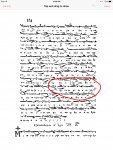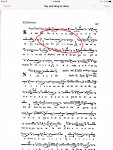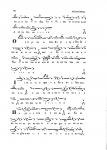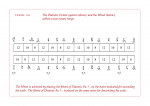Hi Basil,
Thanks for the detailed explanation. Do we really need to conceive of these fthorae in terms of "upper and lower bounds of tetrachords or pentachords," though?
It seems to me that one could say that, if we were to read the music totally analytically and take the fthorae at face value, then we can say - with confidence - that Bou "should" be in its natural position (i.e. 10 moria away from Pa) on both descent and ascent. The alternate interpretation can be attributed to oral tradition.
I don't see why Bou would be flat because of the "law of attraction" - Bou does not exhibit that kind of flatness in Plagal Fourth Mode cadences such as these, and it is only on cadential theseis in First/Plagal First Modes that Bou exhibits the slight downward attraction due to the "gravitational pull," so to speak, of Pa, being that it is the base of the mode. This is a different cadence - finishing on Ni, not Pa - so I don't see why Bou would demonstrate this extreme flatness because of the "law of attraction." Perhaps I am missing something here?
It seems that it might be worth explaining the execution of this particular thesis in terms of oral tradition, and/or the slightly less analytical writing of earlier composers. Perhaps, in oral tradition, it has become acceptable - even common practice - to execute this thesis as if the fthora were actually of diatonic Ke, not diatonic Pa. That is not actually "what the music says" - but, due to oral tradition, it has become acceptable.
Similarly, it has become part of the oral tradition to perform "εκ των ουρανών" of the Third Mode Πάσα Πνοή as if there were a fthora of diatonic Pa on the Ke - even though it is not written that way in the score. Nonetheless, most cantors perform it this way. It has become oral tradition to execute that particular line thusly.
Similarly (although not exactly the same, but for the sake of argument, let's consider it), in plagal first mode heirmologic, many pieces are written from Ke as Ke (not Ke with a diatonic fthora of Pa on it). Nonetheless, cantors perform plagal first heirmologic as if there were a diatonic fthora of Pa placed on the first Ke of the piece. The result, as we all know, is that Ga is sharp (it sounds like Zo of first mode) and the original Zo now behaves like a Bou of first mode, and does not exist the extreme instability we expect it to have in the other diatonic modes (e.g. plagal first mode using the octave system). This treatment of Ke as Pa - even without the fthora - is part of the oral tradition.
Similarly, many sections of plagal first mode sticheraric, when they enter the upper tetrachord, utilize the "τροχός" system (Ke becomes Pa), even though they are not explicitly notated.
The point to all this is that among some earlier composers, the fthorae were perhaps not used as rigidly or as analytically as we use them today. And perhaps we can attribute this alternate execution of the Bou flat in this particular thesis to oral tradition, or to an inexact application of the fthora. But I'm hesitant to explain it simply by saying that the Bou is pulled downward because of the law of attraction, when Bou does not demonstrate this kind of movement in plagal fourth cadences.
-Gabriel





